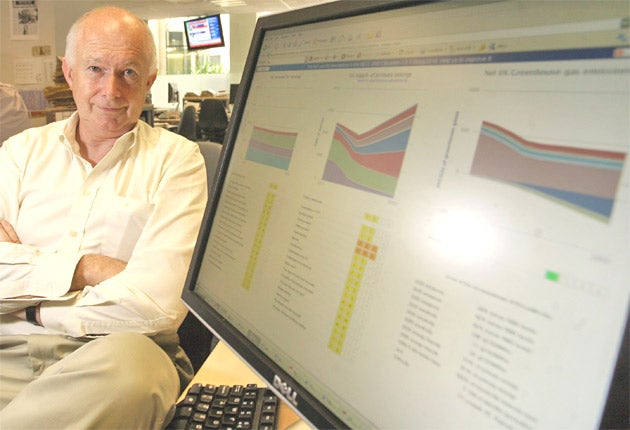How I tried to save the world – from the comfort of my desk
Michael McCarthy is given the chance to put his environmental policies to the test

It's not quite being at the controls of the Starship Enterprise. But it's on the way there.
As from today, you can sit at your laptop or your workstation and redesign UK energy policy for the next 40 years. That's you. Yes, you.
It's simple. You do it using the software the British Government is using itself, and you can pick your own range of policies and measures that will keep the lights on, in the face of looming global threats to energy supply, while simultaneously cutting Britain's emissions of carbon dioxide, the principal greenhouse gas, by 80 per cent – as the Government has pledged.
Once you start doing it, as I did yesterday, you get a feeling of Titanic Power, as in "Hmm. I think I'll close down all coal-fired power plants". (Unspoken thought: And have my picture displayed on all public buildings).
You also get a real sense, deciding with the click of a mouse whether to install 10,000 or 17,000 offshore wind turbines by 2050, or to build 13 nuclear power stations, or 30, or none at all, that in planning the energy future there are necessary choices and trade-offs, and you can't rule something out, without ruling something in. And it's all rather more complex than you might think. Whatever mix you choose, or whatever "pathway", as the Government prefers to term it, the endpoint must be the same: CO2 emissions have to be slashed by 80 per cent in four decades' time – with the lights still kept on.
Doing it yourself gives an unusual and vivid insight into the difficulties faced by real policymakers in grappling with our energy future. The software tool that makes it possible is called the 2050 Pathways Calculator and it is the brainchild of the blue-skies thinker at the Department of Energy and Climate Change (DECC), the chief scientist, Professor David Mackay.
When I began using the calculator yesterday – it's available on the DECC website – I was quickly initiated into the frustrations, as well as the delights, of shaping the future.
The calculator has three lists of measures, which you can see in the columns on the screen, from left to right, under the headings UK demand for energy, UK supply of electricity, and greenhouse gas emissions.
The first has measures affecting demand, such as home heating and insulation, while the second lists power-supply sectors such as wind, solar and nuclear power, and fossil-fuel burning (combined with technology to store the CO2 given off). Each list has four ranges of effort, from one, which is doing virtually nothing, to four, which is doing everything short of breaking the laws of physics. You pick a series of measures and apply a range of effort to each one, and then column three works out for you what the result is, in terms of the percentage cut in CO2 by 2050. I decided to see how much I would cut if I put all the demand measures, and all the supply measures, on level two of effort ("effort described by most stakeholders as achievable").
I did the clicking, and there was the result: Britain's CO2 cut in 2050 by 42 per cent (a long way short of the target). So I ramped up onshore wind from effort level two (8,000 turbines covering the landscape by 2050) to effort level three (13,000 turbines).
Result: nothing. The CO2 cut stayed at 42 per cent. This can't be right, I thought. Bloody government. Bloody software. So I ramped up the offshore wind sector from level two (10,000 turbines surrounding the coasts by 2050) to three (17,000). Result: nothing again. The CO2 stayed on 42 per cent.
Your calculator, I told the DECC press office indignantly, is broken on its first day. Washed up. Rubbish.
Five minutes later I had a call from a man at the DECC whom I can only describe as a boffin, called Jan, and when I explained to him that at the risk of permanent enmity from the Countryside Alliance, I had virtually doubled Britain's wind turbines overnight, yet nothing had happened, he nodded – I can sense people nodding down the phone – and said: "But of course."
He explained: "You are now merely oversupplying decarbonised electricity." There was so much carbon-free electricity in the system I had chosen that adding more didn't actually cut carbon emissions further. "However," he went on, "if you move 'electrification of individual transport' from level two to level three, you will see that the CO2 emissions cut rises from 42 per cent to 43 per cent."
"Ah," I said. "Ah yes." It was in other areas, he added, that the extra cuts needed to be found. Well, I never said it was simple, did I? All right. Maybe I did. But it's fascinating, and you can try it yourself at 2050-calculator-tool.decc.gov.uk.
Join our commenting forum
Join thought-provoking conversations, follow other Independent readers and see their replies
Comments